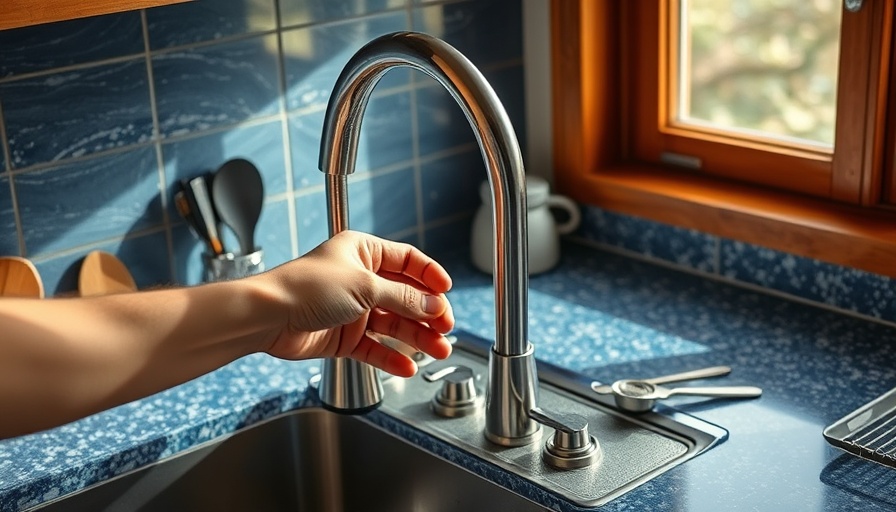
Why Fixing a Dripping Faucet is Essential
A dripping faucet may seem like a trivial issue, but it can lead to significant consequences over time—both for your wallet and the environment. Each drop that escapes contributes to wasted water, potentially raising your bill and leading to over a gallon of wasted water a day. Not only does this impact your finances, but it’s also a call to action for more sustainable practices in your home.
Understanding the Anatomy of Your Faucet
To effectively address the issue, it’s important to understand how your faucet operates. Most kitchen faucets utilize rubber O-rings, washers, or cartridges to control water flow. Deterioration of these components can lead to leaks. Thus, identifying the make and model of your faucet is crucial, as this determines the specific parts you'll need to replace. By learning to navigate your faucet's design, you'll be better equipped for any DIY home repairs.
DIY Faucet Repair Tools and Materials You Need
Before embarking on your repair journey, gather the necessary tools. You will need:
- Adjustable wrench
- Allen wrenches
- Flathead screwdriver
- Needle-nose pliers
- Phillips screwdriver
- Plumber socket set
In terms of materials, be sure to have clean rags and a replacement cartridge on hand. Some users might find it beneficial to have vinegar handy as an option for cleaning parts encrusted with mineral deposits.
Steps to Stop the Drip
Here’s a straightforward guide to fixing that pesky leak:
- Turn Off the Water: Locate the shut-off valves under the sink and turn them off. If there aren’t any valves, turn off the main water supply.
- Remove Caps and Covers: Depending on your faucet design, you may need to take off caps or covers to access the screw that secures the handle.
- Take Off the Handle: Use an Allen wrench to loosen the handle screw, then pull the handle off.
- Replace the Cartridge: Remove the old cartridge, replacing it with the new one. This is typically where the issue lies.
- Reassemble the Faucet: Reverse the disassembly steps, ensuring the handle is secured tightly without overtightening.
- Test the Faucet: Turn the water supply back on and check for leaks. Turn the faucet on and off several times to ensure everything is functioning correctly.
By following these simple steps, you’ll not only save money on plumber fees, but you’ll also gain a sense of pride in your DIY home repair skills.
Beyond the Drip: Proactive Home Maintenance
Fixing a leaky faucet can inspire a wave of proactive maintenance in your home. Consider embarking on other DIY projects around the house. From minor household hacks such as DIY home cleaning tips to larger projects like DIY home renovations on a budget, there’s an opportunity to enhance your living space while promoting sustainability.
Taking the initiative to improve your home also aids in creating a haven that reflects your personality and style. Remember, whether it’s organizing your space or updating old fixtures, every little bit helps with overall home decor and function. Embrace the ideas surrounding DIY home improvement and transformation.
Fostering Sustainable Living through Home Repairs
Undertaking home repairs like fixing a leaky faucet opens the door to a more sustainable lifestyle. It empowers homeowners to take control of their living spaces while being mindful of waste and conservation. You’re also setting a precedent for ongoing home maintenance, ensuring your living environment remains an eco-friendly haven. Every effort towards sustainability matters, especially as we collectively face environmental challenges.
Conclusion: Your Home, Your Responsibility
With a little effort and investment of time, you can fix your leaking kitchen faucet and tackle other DIY home repairs, embracing not only a more sustainable lifestyle but also a skill set that fosters independence and creativity. Don’t wait for that drip to drive you mad; instead, take action—your home and wallet will thank you!
Start your journey toward DIY empowerment and consider exploring more projects that enhance your living space. The benefits extend beyond immediate repairs, promoting an environmentally friendly culture and a commitment to self-sufficiency.
 Add Row
Add Row  Add
Add 




Write A Comment